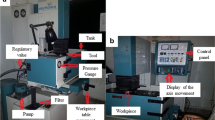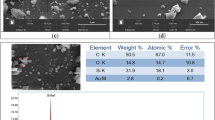Abstract
In manufacturing industry, a material has more than 60 HRC hardness value; conventional methods are not effective as much as non-traditional methods. Therefore, it is required to use alternative methods like electric discharge machining (EDM) which has a high hardness and complex geometry advantages. In this experiment, a EDM method is presented for different electrode grades. Graphite has the much better machining performance for EDM than other electrode materials. EDM is a non-conventional process that mainly used for hard and complex shaped metals which have electrical conductivity. EDM effects on material removal rate (MRR), peak surface roughness (Rz), and electrode wear rate (EWR) were experimentally calculated. Selected parameters were graphite type (HK3, HK15, HK75), current (2, 3, 4), pulse on time (25, 30, 35), and pule of time (15, 20, 25). Differences in the MRR result in the change in the Rz higher values of parameters increased Rz, MRR, and Rz values. In this experiment, Taguchi L9 orthogonal experimental design method has been used on WP7V hybrid tool steel.
Access provided by Autonomous University of Puebla. Download conference paper PDF
Similar content being viewed by others
Keywords
Introduction
Electric discharge machining is similar method with arc welding. Some researched shows that the EDM methods are something like controlling the lightning power. EDM method firstly discovered by English scientist Joseph Presley the method basically controls the abrasive power of electric current and removes material from workpiece and electrode. Figure 75.1 shows the similarity of a process between EDM and lightning. [1, 2]
In the year of 1882, Russian engineer Bernandes discovered arc welding, and this method has become a common in American continentals. Nowadays, arc welding method is still used for joining parts and repairing them [3].
First, EDM applications are started with the World Wars. During the World War II Russian engineer Larezenko invented a system that can control the lightning power. Thanks to this system, electric current can be controlled and workpiece can be abrasively machined [4, 5].
EDM is a cycle that eliminates the material with electrical release between workpiece and terminal. EDM is a warm-based cycle that changes over electrical energy into heat energy [6, 7]. During the measure, workpiece is ionized by dissolving and vaporization. Also, the ionized particles are eliminated by blending with the dielectric liquid, then these particles are separated by the framework. The primary standard of the EDM is the change of the electric energy into heat energy. All the while, electrical energy is working for the make flashes and nuclear power which eliminates material from the outside of the workpiece.
Anode wavers on the outside of the workpiece during the time the hole between them become more modest and the starting happens. Figure 75.2 shows the EDM machine system and its processes [8,9,10].
Schematic representation of EDM [11]
Figure 75.3 shows the stages of EDM; there are six different stages that occur during process;
Phases of electrical releases:
-
a.
Dielectric breakdown,
-
b.
Plasma line arrangement
-
c.
Cathodes liquefying and vaporization
-
d.
Plasma and air pocket expansion
-
e.
Plasma breakdown and garbage discharge
-
f.
Bubble breakdown and deionization.
There are huge loads of learns about the EDM boundaries that impact surface completion quality. There are around 16 parameters which influence the nature of the EDM. Likewise, there are mixes of boundaries 48 which are troublesome distinguished for operation optimization. As per formal encounters and writing research, most effective boundaries are current (1) Ton Toff times (2) and materials (3) [12, 13].
In this research, electrode grade (HK3, HK15, HK75) current (2, 3, 4A), pulse on time (25, 30, 35 µs), and pulse of time pulse off time (15, 20, 25 µs) have been examined. The main purpose of the experiment is the investigate effect of different electrode grades and parameters on hybrid tools steel. According to conventional researches around the literature, it is limited that the graphite electrode grades are not researched enough. Moreover, there is no research about WP7V tool steel in literature. Therefore, this study is unique for its electrode and workpiece material.
Materials and Methods
Experiment has been finished by utilizing PROMPT EDM-542 machine. Dielektrikum 358 which has 2.2 mm2/s thickness at 40°C and lightning point 100° C is used as a dielectric fluid.
Properties of the work material have been presented in the following passage. As per writing survey, the boundaries of the machining have been decided with the end goal of better surface get done with the higher material evacuation rate. During the research, Taguchi L9 matrix has been used, and consequences of the boundary impacts are reported in results part. MS Excel, Minitab, and SolidWorks programmings have been utilized for the methodology of the examination.
Table 75.1 shows electrode grades and their psychical features. Especially, average grain size of the electrode can be seen. Small grain sizes that reduce the contact are of the grain which can create more homogenous sparking.
Before starting the experiment, the Taguchi L9 table has been used. Table 75.2 shows Taguchi L9 design parameters that are used in this experiment. As an experimental outcome, the Rz, MRR, and EWR values are taken as evaluation. In the literature, it is now commonly taken to use Rz values. Due to mechanism of EDM, Rz values should be taken.
Graphite has been purchased as a square block and machined to the same sizes in all experiments, all graphite’s are used once, and experiment procedure is done three times. Machined graphite’s can be seen in Fig. 75.4.
Grinded workpiece and cylindrical graphite bars HK3-HK15-HK75 [14]
Table 75.3 shows chemical composition of WP7V hybrid tools steel. This steel is called hybrid steel due to it can be used in both cold and hot forming operations. For the experimental procedure stability and EDM purpose, workpiece has been hardened to 60–62 HRC hardness and grinded to 0.3 µm. Grinded tool steel can be seen in Fig. 75.4.
Results
In this part, the results of the experiments have been calculated and commented.
There are three sections in results parts; MRR-EWR-Rz.
Result for MRR
Table 75.4 and Fig. 75.5 show the parameters that effect the experimental results; the ampere is the most important parameter for MRR values which is followed by Toff and electrode graphite grades. When the grain size of the electrode becomes bigger, then the MRR rises as expected. According to similar workouts, these results are applicable.
When Figs. 75.5 and 75.6 are calculated, the bigger is better option which is used for MRR.
For EWR Values
Table 75.5 and Fig. 75.6 show the parameters that effect the experimental results; the ampere is the most important parameter for EWR values which is followed by Ton and Toff. When the grain size of the electrode becomes bigger, the EWR rises as expected. According to similar studies, these results are applicable.
When Table 75.5 and Fig. 75.6 are calculated, the smaller is better option which is used for EWR.
Figure 75.7. presents 1000 × microscope pictures of the workpiece. The surface quality of the process can discernible.
For Rz Values
Table 75.6 and Fig. 75.8 show the parameters that effect the experimental results; the ampere is the most important parameter for Rz values which is followed by Ton and electrode. When the grain size of the electrode becomes bigger, the Rz rises as expected. According to similar studies, these results are applicable.
When Table 75.6 and Fig. 75.8 are calculated, the smaller is better option which is used for Rz.
Conclusion
This experimental study is solved a manufacturing problem during the procedure. The calculated results are a manual for machining process plan.
EDM is not a new method; it has a background like more than a century, EDM applications for tools steels and especially specific steels are limited. EDM methods play a huge role in non-traditional manufacturing methods. EDM’s main advantage is for machining of hardened steels and also very complex shapes. EDM parameters directly effect the machining performance.
-
Rz (average difference between peak and valley) value is directly affected by ampere of the process. Second parameter is pulse on time, and electrode materials follows them. For better surface finish, small grain size graphite should be used.
-
Taguchi is not enough for experimental design. Annova should be also used to understand the percentage of parameters.
-
For electrode wear rate (EWR), ampere is the most important parameter for EWR values which is followed by Ton, Toff, lastly electrode material.
-
Ampere is the most important parameter for MRR values which is followed by Toff, electrode graphite grades, and Toff values.
-
In rough operations, bigger grain size electrodes, in finishing operations, small grain size electrodes must be used.
References
Shah RA, Darji PA (2011) A review-an experimental effect of electrode material on MRR, kerf width and surface roughness of Aisi D2 tool steel In WEDM. Indian J Appl Res 3(12):211–213
Mohri N, Tani T (2006) Recent evolution of electrical discharge machining. In 4M 2006—second international conference on multi-material micro manufacture, pp 23–26
The history of welding (n.d.) Retrieved March 31, 2021, from https://www.millerwelds.com/resources/article-library/the-history-of-welding
Stavitskii BI (2010) Glimpses of the history Of electrospark machining of materials (dedicated to the centenary of B.R. and N.I. lazarenko—the inventors of the method of electrospark machining of Metals, alloys, and other Conducting materials). Surface Eng Appl Electrochem 46(6):634–645
Schumacher B, Krampitz R, Kruth J (2013) Historical phases of EDM development driven by the DUAL influence of “Market Pull” and “science push.” Procedia CIRP 6:5–12
Benedict GF (2017) Electrical discharge machining (EDM). Nontraditional manufacturing processes, pp 207–229
Yadav RN (2016) Edm of aisi d3 Die steel using SIC as dielectric. Int J Emerg Trends Sci Technol, ARIMPIE-2016, p 6
Nagpal P (2016) Optimization and analysis of process parameters on MRR in EDM of AISI D3 Die steel using SIC as dielectric. Int J Emerg Trends Sci Technol 03(09):4562–4570
Liu Q, Zhang Q, Zhang M, Zhang J (2016) Review of size effects in micro electrical discharge machining. Precis Eng 44:29–40
Czelusniak T, Higa CF, Torres RD, Laurindo CA, De Paiva Júnior JM, Lohrengel A, Amorim FL (2018) Materials used for sinking edm electrodes: a review. J Brazilian Soc Mech Sci Eng 41(1)
Shirguppikar SS, Dabade UA (2018) Experimental investigation of dry electric discharge machining (dry edm) process on bright mild steel. Mater Today: Proc 5(2):7595–7603
Balasubramanian P, Senthilvelan T (2014) Optimization of machining parameters in EDM process using cast and sintered copper electrodes. Procedia Mater Sci 6:1292–1302
Kharola A (2016) A comparative study of Machining parameters ON Die-sinking electrical discharge machining (EDM) using copper and ALUMINIUM electrodes on hard Steels. Int J Mater Forming Mach Process 3(1):22–44
WP7V special STEEL Materials: Saglam metal (n.d.) Retrieved March 31, 2021, from https://www.saglammetal.com/en/product-detail/tool-steels/new-generation-tool-steels/wp7v-material
Jauna Reklama W (n.d.) Graphite grades tokai carbon. Retrieved March 31, 2021, from https://www.edmbaltic.lt/en/products/edm-products/graphite.htm
Acknowledgements
Author would like to thank Repkon Machine & Tools Company that funds the experiment.
Author information
Authors and Affiliations
Corresponding author
Editor information
Editors and Affiliations
Rights and permissions
Copyright information
© 2023 The Author(s), under exclusive license to Springer Nature Singapore Pte Ltd.
About this paper
Cite this paper
Yaman, S., Cakir, O. (2023). Investigation on Effects of Different Graphite Grades on Electric Discharge Machining of Hybrid Tool Steel. In: Manik, G., Kalia, S., Verma, O.P., Sharma, T.K. (eds) Recent Advances in Mechanical Engineering. Lecture Notes in Mechanical Engineering. Springer, Singapore. https://doi.org/10.1007/978-981-19-2188-9_75
Download citation
DOI: https://doi.org/10.1007/978-981-19-2188-9_75
Published:
Publisher Name: Springer, Singapore
Print ISBN: 978-981-19-2187-2
Online ISBN: 978-981-19-2188-9
eBook Packages: EngineeringEngineering (R0)












